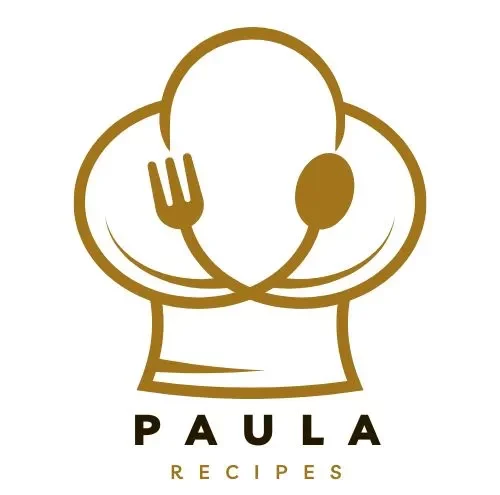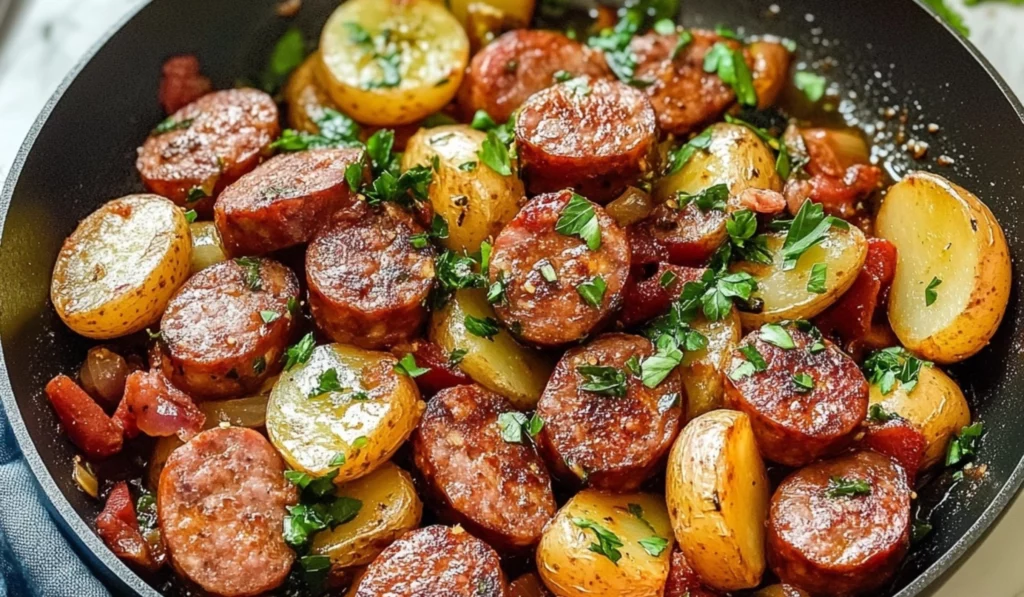Picture this: crispy, golden-brown potatoes, perfectly seasoned and caramelized to perfection, savory sausage sizzling in a skillet, releasing its irresistible aromas, vibrant bell peppers adding a touch of sweetness and color, and the fragrant blend of smoked paprika and Italian seasoning filling your kitchen with warmth. This isn’t a gourmet meal from a fancy restaurant; it’s the magic of the Sausage and Potatoes Skillet, a one-pan dish that’s as simple to make as it is incredibly delicious. I remember the first time I made this skillet. I was a busy weeknight, I was craving something hearty and flavorful, but I didn’t want to spend hours in the kitchen. I stumbled upon this recipe, and it was a total game-changer! It was so incredibly easy to throw together – just a matter of chopping some vegetables and tossing everything in a skillet – and the cleanup was an absolute breeze. Now, this Sausage and Potatoes Skillet is a staple in my weeknight meal rotation, and it’s always a crowd-pleaser.
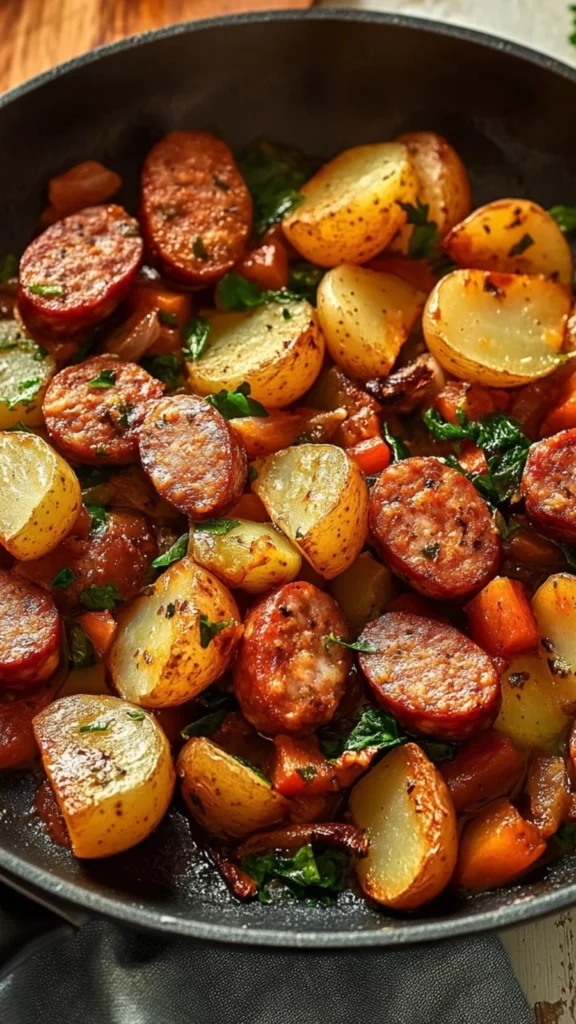
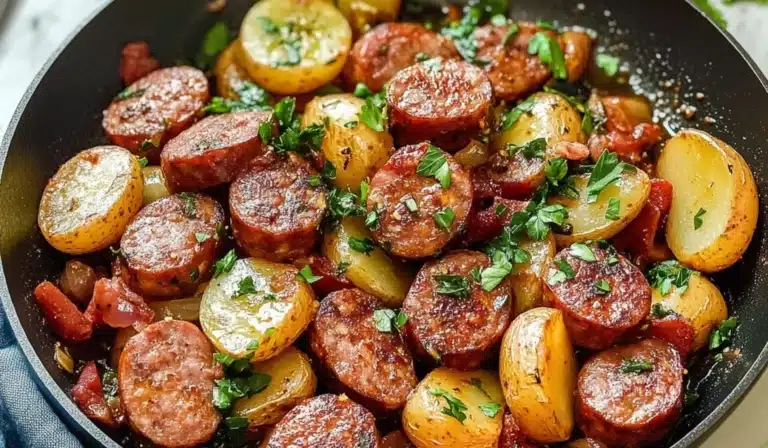
Sausage and Potatoes Skillet: A One-Pan Wonder for Easy Weeknight Meals
Craving a quick, easy, and delicious weeknight dinner? This Sausage and Potatoes Skillet is the perfect solution! Crispy potatoes, savory sausage, and colorful vegetables all cooked together in one pan for minimal cleanup.
- Total Time: 35 minutes
- Yield: 4 servings 1x
Ingredients
- 1 pound smoked sausage, sliced
- 1 1/2 pounds baby potatoes, halved or quartered
- 2 tablespoons olive oil
- 1 medium onion, diced
- 2 cloves garlic, minced
- 1 teaspoon smoked paprika
- 1 teaspoon Italian seasoning
- 1/2 teaspoon salt
- 1/4 teaspoon black pepper
- 1 bell pepper, sliced
- 1 cup fresh spinach (optional)
- 2 tablespoons fresh parsley, chopped (for garnish)
Instructions
- Parboil Potatoes: Place the halved or quartered potatoes in a large pot and cover them with cold, salted water. Bring the water to a boil, then reduce the heat and simmer for 8-10 minutes, or until the potatoes are fork-tender. This step is crucial for ensuring that the potatoes are cooked through and tender by the time the sausage and other vegetables are ready. Parboiling also helps the potatoes to develop a crispy exterior when they’re cooked in the skillet. Beginner Note: Parboiling means partially cooking the potatoes. They don’t need to be completely cooked through at this stage; they should be slightly softened but still firm.
- Drain and Set Aside: Once the potatoes are parboiled, drain them thoroughly using a colander and set them aside. This will prevent them from continuing to cook and becoming mushy. Beginner Note: Make sure the potatoes are well drained to prevent excess moisture in the skillet.
- Cook Sausage: Heat 1 tablespoon of olive oil in a large skillet (preferably cast iron for even heat distribution and a crispy crust) over medium heat. Add the sliced sausage and cook until browned on both sides, about 4-5 minutes. This step not only cooks the sausage but also renders out some of the fat, adding flavor to the skillet. Remove the cooked sausage from the skillet and set it aside. Beginner Note: Cooking the sausage first prevents it from overcooking later when you add the other ingredients. You want the sausage to be nicely browned and cooked through, but not dried out.
- Sauté Onion and Garlic: In the same skillet (don’t discard the rendered fat – it’s full of flavor!), add the remaining 1 tablespoon of olive oil (if needed – you might have enough fat from the sausage) and sauté the diced onion and minced garlic until fragrant and softened, about 2 minutes. This step builds a flavorful base for the entire dish. Beginner Note: Sautéing means cooking the onion and garlic over medium heat until they are softened and fragrant, but not browned or burned. Garlic can burn easily, so watch it closely.
- Add Bell Pepper: Add the sliced bell pepper to the skillet and cook for another 3-4 minutes, or until it is slightly softened and beginning to caramelize. The bell pepper will add sweetness, color, and a bit of crunch to the dish. Beginner Note: You can adjust the cooking time depending on how crisp-tender you like your bell peppers. If you prefer them softer, cook them a little longer.
- Add Potatoes and Seasonings: Add the parboiled potatoes to the skillet along with the smoked paprika, Italian seasoning, salt, and black pepper. Stir everything together well, ensuring that the potatoes are coated with the seasonings and the rendered fat in the skillet. Cook for 5-7 minutes, stirring occasionally, until the potatoes are golden brown and crispy on all sides. This step creates a beautiful color and texture on the potatoes and infuses them with flavor. Beginner Note: Don’t overcrowd the skillet. If necessary, cook the potatoes in batches to ensure even browning and crispiness. Overcrowding will cause the potatoes to steam instead of crisping up.
- Combine All Ingredients: Return the cooked sausage to the skillet and toss everything together until well combined. Make sure all the ingredients are evenly distributed in the skillet and heated through. Beginner Note: Combining all the ingredients at this stage allows the flavors to meld together beautifully.
- Add Spinach (Optional): If using spinach, stir it into the skillet during the last 2 minutes of cooking. The residual heat from the other ingredients will be enough to wilt the spinach. Beginner Note: Spinach wilts very quickly, so you don’t need to cook it for long. Adding it at the end preserves its vibrant green color and prevents it from becoming mushy.
- Garnish and Serve: Garnish the Sausage and Potatoes Skillet with fresh chopped parsley just before serving. This adds a touch of freshness and visual appeal to the dish. Serve hot and enjoy! Beginner Note: Garnishing adds a final touch of flavor and visual appeal to the dish.
Notes
- Use any type of sausage you prefer.
- Don’t overcrowd the skillet.
- Adjust seasonings to taste.
- Prep Time: 10 minutes
- Cook Time: 25 minutes
- Category: Main Course, Dinner
- Method: Sautéing
- Cuisine: American
This recipe is absolutely perfect for beginner cooks. It’s fast, requires minimal ingredients and prep work, and is a fantastic way to enjoy a healthy and satisfying meal without any complicated cooking techniques or fancy equipment. Plus, it’s incredibly versatile – you can easily customize it to your liking, swapping out ingredients, adding your favorite vegetables, and adjusting the seasonings to create your own signature skillet masterpiece. If you’re looking for a quick, easy, and satisfying meal that’s perfect for busy weeknights, lazy weekends, or any occasion when you want a delicious meal without the fuss, this Sausage and Potatoes Skillet is the answer.
Ingredients and Preparation: The Building Blocks of Skillet Success
This recipe uses simple, readily accessible ingredients, making it a breeze for even the most novice cooks to assemble.
- 1 pound smoked sausage (such as kielbasa or andouille), sliced into ½-inch pieces – Alternative: You can use any type of sausage you prefer, such as Italian sausage (sweet or spicy), bratwurst, chorizo, or even chicken sausage for a leaner option. For a vegetarian version, try using plant-based sausage, halloumi cheese (which holds its shape and browns beautifully), or even large chunks of firm tofu that have been pressed to remove excess water.
- 1 ½ pounds baby potatoes (such as Yukon Gold or red potatoes), halved or quartered depending on size – Alternative: You can use larger potatoes, but you’ll need to cut them into smaller pieces and adjust the cooking time accordingly. Sweet potatoes also work exceptionally well in this recipe, adding a touch of sweetness and vibrant color. You can also use a mix of different types of potatoes for added variety.
- 2 tablespoons olive oil (divided) – Alternative: You can use other cooking oils with a high smoke point, such as canola oil, avocado oil, or even grapeseed oil. Butter can also be used for a richer flavor, but be careful not to let it burn. Clarified butter or ghee are good options if you want the flavor of butter but with a higher smoke point.
- 1 medium onion, diced – Alternative: You can use red onion, white onion, yellow onion, or even shallots. You can also add other root vegetables, such as diced carrots or celery, along with the onion to add more depth of flavor.
- 2 cloves garlic, minced – Alternative: You can use garlic powder (about 1 teaspoon) if you don’t have fresh garlic on hand. You can also add a pinch of red pepper flakes along with the garlic for a bit of heat. Roasted garlic adds a mellow sweetness if you have some prepared.
- 1 teaspoon smoked paprika (for a rich, smoky flavor) – Alternative: You can use regular paprika, but the flavor will be noticeably different – it will lack the smoky depth. You can also add other spices, such as chili powder, cumin, or coriander, for a different flavor profile.
- 1 teaspoon Italian seasoning (a blend of herbs like oregano, basil, and thyme) – Alternative: You can use individual dried herbs, such as oregano, basil, and thyme, or you can use a different herb blend, such as Herbes de Provence. Fresh herbs, like rosemary or sage, can also be used, but add them towards the end of cooking.
- ½ teaspoon salt (or to taste – start with less and add more as needed)
- ¼ teaspoon black pepper (or to taste – freshly ground black pepper is always a good choice)
- 1 bell pepper (any color), sliced – Alternative: You can use multiple bell peppers of different colors for a more visually appealing and nutritionally diverse dish. You can also add other vegetables, such as zucchini, yellow squash, mushrooms, broccoli florets, or asparagus, along with the bell pepper.
- 1 cup fresh spinach (optional, for added nutrients and color) – Alternative: You can use other leafy greens, such as kale (chopped small), Swiss chard, or collard greens. If using heartier greens like kale or collard greens, add them earlier in the cooking process so they have enough time to wilt and soften.
- 2 tablespoons fresh parsley, chopped (for garnish)
Step-by-Step Instructions: Creating Skillet Magic
These easy-to-follow instructions will guide you through each step of creating your delicious Sausage and Potatoes Skillet:
- Parboil Potatoes: Place the halved or quartered potatoes in a large pot and cover them with cold, salted water. Bring the water to a boil, then reduce the heat and simmer for 8-10 minutes, or until the potatoes are fork-tender. This step is crucial for ensuring that the potatoes are cooked through and tender by the time the sausage and other vegetables are ready. Parboiling also helps the potatoes to develop a crispy exterior when they’re cooked in the skillet. Beginner Note: Parboiling means partially cooking the potatoes. They don’t need to be completely cooked through at this stage; they should be slightly softened but still firm.
- Drain and Set Aside: Once the potatoes are parboiled, drain them thoroughly using a colander and set them aside. This will prevent them from continuing to cook and becoming mushy. Beginner Note: Make sure the potatoes are well drained to prevent excess moisture in the skillet.
- Cook Sausage: Heat 1 tablespoon of olive oil in a large skillet (preferably cast iron for even heat distribution and a crispy crust) over medium heat. Add the sliced sausage and cook until browned on both sides, about 4-5 minutes. This step not only cooks the sausage but also renders out some of the fat, adding flavor to the skillet. Remove the cooked sausage from the skillet and set it aside. Beginner Note: Cooking the sausage first prevents it from overcooking later when you add the other ingredients. You want the sausage to be nicely browned and cooked through, but not dried out.
- Sauté Onion and Garlic: In the same skillet (don’t discard the rendered fat – it’s full of flavor!), add the remaining 1 tablespoon of olive oil (if needed – you might have enough fat from the sausage) and sauté the diced onion and minced garlic until fragrant and softened, about 2 minutes. This step builds a flavorful base for the entire dish. Beginner Note: Sautéing means cooking the onion and garlic over medium heat until they are softened and fragrant, but not browned or burned. Garlic can burn easily, so watch it closely.
- Add Bell Pepper: Add the sliced bell pepper to the skillet and cook for another 3-4 minutes, or until it is slightly softened and beginning to caramelize. The bell pepper will add sweetness, color, and a bit of crunch to the dish. Beginner Note: You can adjust the cooking time depending on how crisp-tender you like your bell peppers. If you prefer them softer, cook them a little longer.
- Add Potatoes and Seasonings: Add the parboiled potatoes to the skillet along with the smoked paprika, Italian seasoning, salt, and black pepper. Stir everything together well, ensuring that the potatoes are coated with the seasonings and the rendered fat in the skillet. Cook for 5-7 minutes, stirring occasionally, until the potatoes are golden brown and crispy on all sides. This step creates a beautiful color and texture on the potatoes and infuses them with flavor. Beginner Note: Don’t overcrowd the skillet. If necessary, cook the potatoes in batches to ensure even browning and crispiness. Overcrowding will cause the potatoes to steam instead of crisping up.
- Combine All Ingredients: Return the cooked sausage to the skillet and toss everything together until well combined. Make sure all the ingredients are evenly distributed in the skillet and heated through. Beginner Note: Combining all the ingredients at this stage allows the flavors to meld together beautifully.
- Add Spinach (Optional): If using spinach, stir it into the skillet during the last 2 minutes of cooking. The residual heat from the other ingredients will be enough to wilt the spinach. Beginner Note: Spinach wilts very quickly, so you don’t need to cook it for long. Adding it at the end preserves its vibrant green color and prevents it from becoming mushy.
- Garnish and Serve: Garnish the Sausage and Potatoes Skillet with fresh chopped parsley just before serving. This adds a touch of freshness and visual appeal to the dish. Serve hot and enjoy! Beginner Note: Garnishing adds a final touch of flavor and visual appeal to the dish.
Beginner Tips and Notes: Your Kitchen Companion
Even simple recipes have a few tricks to make them even better:
- Parboiling for Perfect Potatoes Every Time: Parboiling the potatoes is a crucial step to ensure that they are cooked through and tender by the time the sausage and other vegetables are ready. If you skip this step, the potatoes may not be fully cooked, even if the other ingredients are done. Parboiling also helps the potatoes to develop a nice, crispy exterior when they’re cooked in the skillet.
- Don’t Overcrowd the Skillet for Even Cooking: Don’t overcrowd the skillet, as this will cause the ingredients to steam instead of brown and crisp. If the skillet is too crowded, the heat won’t be distributed evenly, and the food will take longer to cook. If necessary, cook the ingredients in batches to ensure even browning and crispiness. A large skillet or even a Dutch oven can be helpful for larger quantities.
- Adjust Seasoning to Your Personal Taste: Feel free to adjust the amount of salt, pepper, and other seasonings to your liking. Taste the dish before serving and add more seasoning if needed. Don’t be afraid to experiment with different spices and herbs to create your own unique flavor profile. A pinch of red pepper flakes can add a nice touch of heat, or you can add a dash of your favorite hot sauce for a bolder flavor.
- Use a Cast Iron Skillet for Best Results: A cast iron skillet is ideal for this recipe because it distributes heat evenly and helps to create a crispy crust on the potatoes. Cast iron skillets also retain heat very well, keeping the food warm for longer. If you don’t have a cast iron skillet, you can use another large skillet, but keep in mind that the cooking time and results may vary slightly.
- Prep Ingredients in Advance to Save Time: To save time on busy weeknights, you can slice the sausage, chop the onion, mince the garlic, slice the bell pepper, and chop the parsley ahead of time and store them in separate airtight containers in the refrigerator. You can also parboil the potatoes ahead of time and store them in the refrigerator until you’re ready to use them. This will make the cooking process much faster when you’re ready to put the meal together.
- Keep an Eye on the Garlic: Garlic can burn very easily, so watch it closely while it’s sautéing. If it starts to brown too quickly, reduce the heat or remove it from the skillet until the other ingredients are cooked. Burnt garlic has a bitter taste and can ruin the flavor of the dish.
- Use Quality Sausage for Best Flavor: The flavor of the sausage plays a big role in the overall taste of the dish, so choose a high-quality sausage that you enjoy. Smoked sausage, kielbasa, and andouille sausage are all popular choices for this recipe.
- Don’t Be Afraid to Add More Vegetables: This recipe is very versatile, and you can easily add other vegetables to the skillet. Diced carrots, celery, mushrooms, zucchini, yellow squash, broccoli florets, and asparagus are all great additions. Just adjust the cooking time as needed depending on the type of vegetables you add.
Serving Suggestions: Completing the Skillet Experience
This Sausage and Potatoes Skillet is delicious and satisfying on its own, but you can also enhance it with some complementary sides and pairings to create a complete and well-rounded meal.
- Crusty Bread for Sopping Up the Delicious Juices: Serve the skillet with a side of crusty bread, such as a baguette or sourdough bread, for dipping into the flavorful juices that accumulate in the skillet. The bread will soak up all the deliciousness, and it’s a great way to use up every last bit of flavor.
- Fresh Salad for a Light and Refreshing Counterpoint: A fresh green salad, such as a mixed green salad, a Caesar salad, or a simple vinaigrette salad, makes a great accompaniment to this hearty and savory dish. The salad will add a light and refreshing counterpoint to the richness of the skillet.
- Eggs for a Hearty Breakfast or Brunch Option: For a breakfast or brunch option, add some fried or scrambled eggs to the skillet. The eggs will add extra protein and make the meal even more satisfying. You can also add a sprinkle of cheese, such as cheddar or Monterey Jack, for extra flavor.
- Dipping Sauces for Added Flavor and Fun: Serve the skillet with your favorite dipping sauces, such as ketchup, mustard, hot sauce, aioli, or even a creamy ranch dressing. Dipping sauces add extra flavor and make the meal more fun and interactive.
- Storage Tips for Leftovers: Store leftover Sausage and Potatoes Skillet in an airtight container in the refrigerator for up to 3 days. Reheat in the microwave or on the stovetop. You can also freeze leftovers for longer storage. To reheat on the stovetop, add a little bit of olive oil to the skillet and cook over medium heat until heated through.
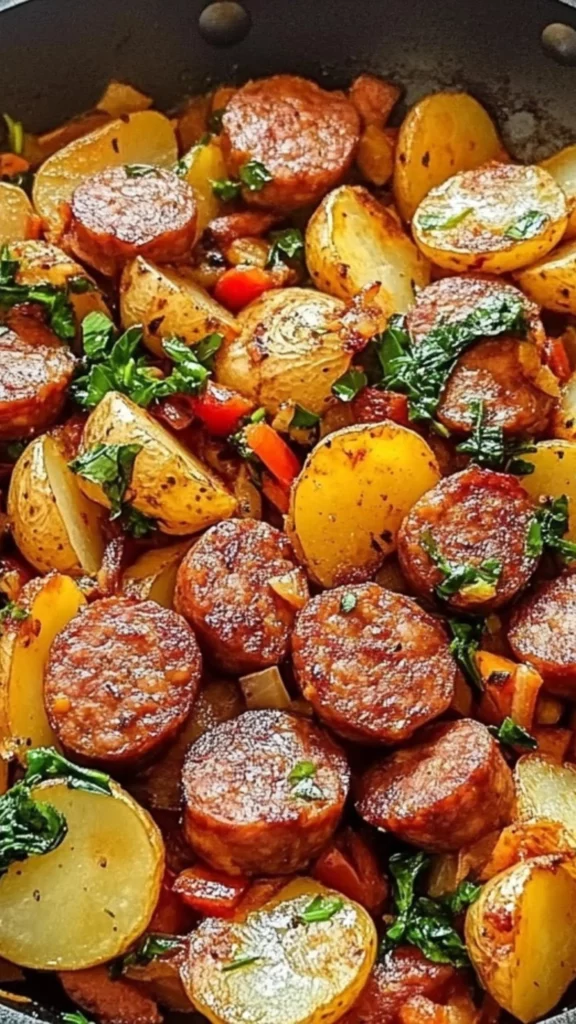
Conclusion: A Skillet Sensation
This Sausage and Potatoes Skillet is a quick, easy, and delicious meal that’s perfect for any occasion. It’s easy to customize, making it a great option for even the pickiest eaters. It’s a fantastic way to get a flavorful and satisfying meal on the table without spending hours in the kitchen. I encourage you to try this recipe and make it your own. Don’t be afraid to experiment with different ingredients and toppings to create your perfect skillet meal. Perhaps you’ll discover a new favorite combination that you’ll want to share with friends and family. Most importantly, have fun and enjoy the process of creating something delicious! Share your culinary creations and experiences in the comments below – I’d love to see your variations! This easy sheet pan dinner is a great way to get a healthy and delicious meal on the table in minutes. It’s a quick and healthy meal that’s perfect for busy weeknights. And the best part? It’s so easy to customize! You can add your favorite vegetables, sauces, and toppings to create a meal that’s perfect for you. So, go ahead, give it a try! You won’t be disappointed. This lemon herb chicken recipe is a great way to add some flavor to your chicken. It’s quick and easy to make, and it’s perfect for a weeknight meal. And who doesn’t love a quick and healthy meal? This Sausage and Potatoes Skillet is all of that and more! It is a delicious and satisfying meal that’s perfect for any occasion. So, what are you waiting for? Get cooking!
